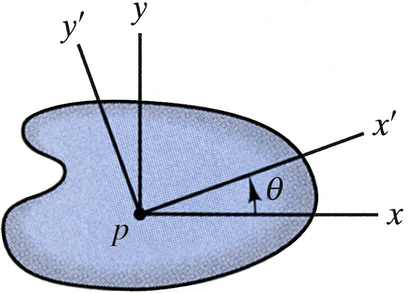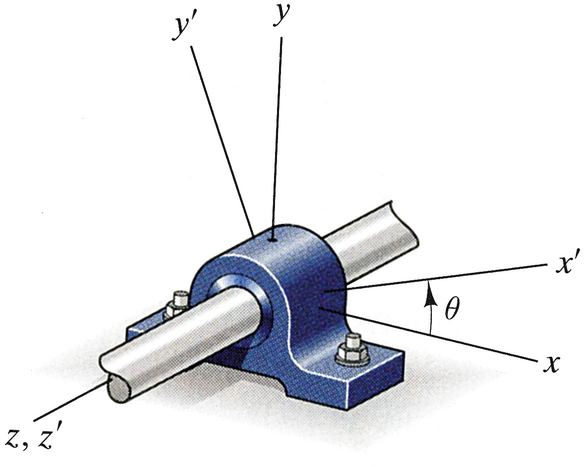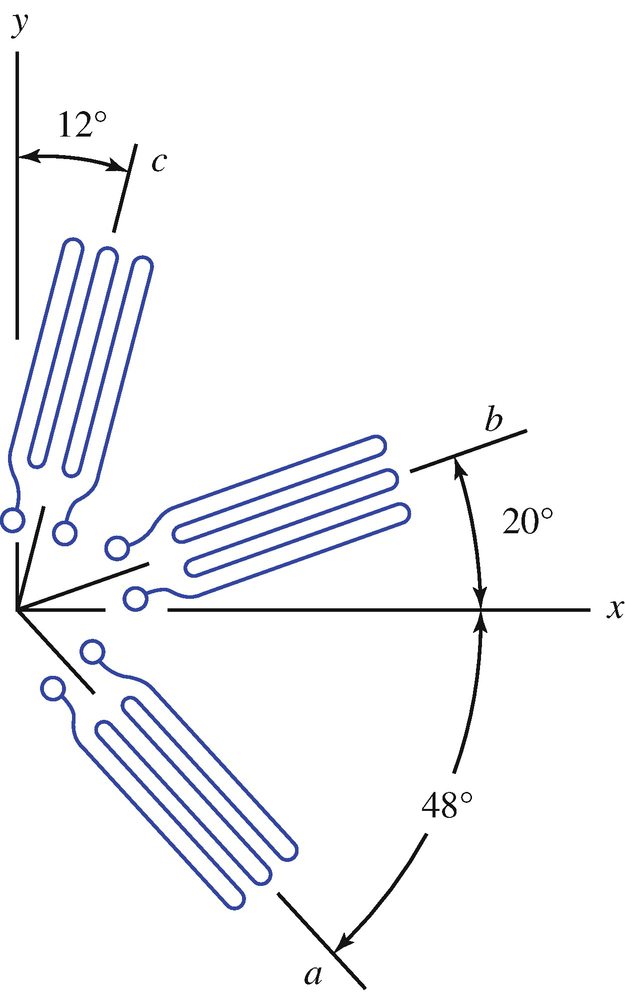Abstract
The six components εx, εy, εz, γxy, γxz, and γyz of the state of strain at a point in terms of a given cartesian coordinate system were defined in Chapter 2. The definition of plane strain and the derivation of relations for the strain components εx′, εy′ and γx′y′ as functions of θ are presented which are entirely analogous to the corresponding results for plane stress. A description is given of the strain gauges commonly used for measuring normal strains. A set of three strain gauges measuring normal strains in three different directions near a given point are known as a strain-gauge rosette. The results can be used to determine the state of plane strain, including the shear strain, at the point. Determination of the maximum and minimum normal strains and the maximum magnitude of the shear strain is discussed. The application of Mohr’s circle to states of plane strain, altogether equivalent to the process for states of stress, is described. The stress-strain relations of a linear elastic material and the concept of isotropy are introduced. A relationship for the shear modulus in terms of the modulus of elasticity and Poisson’s ratio is derived. The bulk modulus of a material is defined and given as an expression in terms of the modulus of elasticity and Poisson’s ratio.
Access this chapter
Tax calculation will be finalised at checkout
Purchases are for personal use only
Author information
Authors and Affiliations
Appendices
Chapter Summary
8.1.1 Components of Strain
In terms of a given coordinate system, the state of strain at a point p of a material is defined by the components of strain:
The components εx, εy, and εz are the normal strains in the x, y, and z directions. The component γxy = γyx is the shear strain referred to the positive directions of the x and y axes, and the components γyz = γzy and γxz = γzx are defined similarly.
Consider a volume dV0 of material in a reference state. Its volume in the deformed state is
The dilatation is the change in volume of the material per unit volume:
8.1.2 Transformations of Plane Strain
The strain at a point p is said to be a state of plane strain if it is of the form
In terms of a coordinate system x′y′z′ oriented as shown in Fig. (a), the components of strain are


For an isotropic linear elastic material, Eqs. (8.7), (8.8), and (8.9) also apply to the components of strain resulting from a state of plane stress.
8.1.3 Strain Gauge Rosette
Suppose that a material is subject to an unknown state of plane strain relative to the x-y coordinate system in Fig. (a). A strain gauge rosette measures the normal strain \( {\varepsilon}_{x^{\prime }} \) in three different directions: θa, θb, and θc. Let the measured strains be εa, εb, and εc. Using Eq. (8.6) to express these strains in terms of the strain components εx, εy, and γxy gives
This system of equations can be solved for the strain components εx, εy, and γxy.
8.1.4 Maximum and Minimum Strains in Plane Strain
A value of θ for which the normal strain is a maximum or minimum is determined from the equation
The values of the principal strains can be obtained by substituting θp into Eqs. (8.7) and (8.8). Their values can also be determined from the equation
although this equation does not indicate their directions. An infinitesimal square element oriented as shown in Fig. (b) is subjected to the principal strains in the x′ and y′ directions and undergoes no shear strain.


A value of θ for which the in-plane shear strain is a maximum or minimum is determined from the equation
The corresponding shear strain can be obtained by substituting θs into Eq. (8.9). The magnitude of the maximum in-plane shear strain can be determined from the equation
The absolute maximum shear strain is
8.1.5 Mohr’s Circle for Plane Strain
Given a state of plane strain εx, εy, and γxy, establish a set of horizontal and vertical axes with normal strain measured to the right along the horizontal axis and shear strain measured downward along the vertical axis. Plot two points, point P with coordinates (εx, γxy/2) and point Q with coordinates (εx, −γxy/2). Draw a straight line connecting points P and Q. Using the intersection of the straight line with the horizontal axis as the center, draw a circle that passes through the two points (Fig. (c)). Draw a straight line through the center of the circle at an angle 2θ measured counterclockwise from point P. Point P′ at which this line intersects the circle has coordinates \( \left({\varepsilon}_{x^{\prime }},{\gamma}_{x^{\prime }{y}^{\prime }}/2\right), \) and point Q′ has coordinates \( \left({\varepsilon}_{y^{\prime }},-{\gamma}_{x^{\prime }{y}^{\prime }}/2\right) \) (Fig. (d)).


8.1.6 Stress-Strain Relations
A material for which the state of stress at a point is a single-valued function of the current state of strain at that point is said to be elastic. If the function is invariant under changes of orientation of the coordinate system relative to the material, the material is isotropic. If the components of strain are linear functions of the components of stress, the material is linear elastic. The stress-strain relations for an isotropic linear elastic material are
The shear modulus is related to the modulus of elasticity and Poisson’s ratio by
The stress-strain relations can also be expressed as
where λ and μ are the Lamé constants. The constant μ = G, and the constant λ is given in terms of the modulus of elasticity and Poisson’s ratio by
Let an isotropic linear elastic material be subjected to a pressure P so that σx = −P, σy = −P, and σz = −P. The bulk modulus K of the material is the ratio of −P to the dilatation
In terms of the modulus of elasticity and Poisson’s ratio, the bulk modulus is
Review Problems
-
8.68
The components of plane strain at point p are εx = 0, εy = 0, and γxy = 0.004. If θ = 45º, what are the strains \( {\varepsilon}_{x^{\prime }},{\varepsilon}_{y^{\prime }} \), and \( {\gamma}_{x^{\prime }{y}^{\prime }} \) at point p?

Problems 8.68–8.69
-
8.69
The components of plane strain at point p are εx = −0.0024, εy = 0.0012, and γxy = −0.0012. If θ = 25º, what are the strains \( {\varepsilon}_{x^{\prime }},{\varepsilon}_{y^{\prime }} \), and \( {\gamma}_{x^{\prime }{y}^{\prime }} \) at point p?
-
8.70
A point p of the bearing’s housing is subjected to a state of plane stress, and the strain components εx' = 0.0024, εy' = 0.0044, and γx' y' = −0.0030. If θ = 20º, what are the strains εx, εy, and γxy at p?

Problems 8.70–8.71
-
8.71∗
A point p of the bearing’s housing is subjected to the state of plane strain εx = 0.0032, εy = −0.0026, and γxy = 0.0044. If \( {\varepsilon}_{x^{\prime }}=0.0037 \) and \( {\varepsilon}_{y^{\prime }}=-0.0031, \)determine the angle θ and the strain \( {\gamma}_{x^{\prime }{y}^{\prime }} \) at p.
-
8.72
The strains measured by a strain gauge rosette oriented as shown are εa = −0.00116, εb = −0.00065, and εc = 0.00130. Determine the strains εx, εy, and γxy.

Problem 8.72
-
8.73
The state of plane strain at a point is εx = 0.003, εy = 0.001, and γxy = –0.006. Determine the magnitude of the maximum in-plane shear strain.
-
8.74
For the state of plane strain εx = 0.0025, εy = 0, and γxy = −0.005, what is the absolute maximum shear strain?
-
8.75
For the state of plane strain εx = −0.008, εy = −0.006, and γxy = −0.012, what is the absolute maximum shear strain?
-
8.76
A drill bit is made of steel with modulus of elasticity E = 200 GPa and Poisson’s ratioν = 0.28. At a point p, the bit is subjected to a state of plane stress, and the components of strainεx = −0.0024, εy = 0.0044, and γxy = −0.0030. What is the state of stress at p?
-
8.77
A drill bit is made of steel with modulus of elasticity E = 200 GPa and Poisson’s ratioν = 0.28. At a point p, the bit is subjected to a state of plane stress, and the components of strainεx = 0.0038, εy = 0.0066, and γxy = −0.0048. What is the component of strain εz at p?
-
8.78∗
Beginning with Eq. (8.59), show that the bulk modulus is given in terms of the Lamé constants by
$$ K=\lambda +\frac{2}{3}\mu . $$
Rights and permissions
Copyright information
© 2020 Springer Nature Switzerland AG
About this chapter
Cite this chapter
Bedford, A., Liechti, K.M. (2020). States of Strain and Stress-Strain Relations. In: Mechanics of Materials. Springer, Cham. https://doi.org/10.1007/978-3-030-22082-2_8
Download citation
DOI: https://doi.org/10.1007/978-3-030-22082-2_8
Publisher Name: Springer, Cham
Print ISBN: 978-3-030-22081-5
Online ISBN: 978-3-030-22082-2
eBook Packages: EngineeringEngineering (R0)







